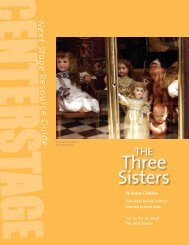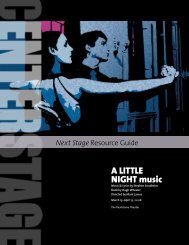The Matchmaker - Center Stage
The Matchmaker - Center Stage
The Matchmaker - Center Stage
You also want an ePaper? Increase the reach of your titles
YUMPU automatically turns print PDFs into web optimized ePapers that Google loves.
Glossary<br />
continued<br />
…arranging it. I am helping him find a suitable bride.<br />
Matchmaking and arranged marriages appeared in America<br />
with the waves of 19th-century immigrants from Europe,<br />
who continued their Old World customs. European Jews used<br />
matchmakers from the 12 th Century on, and they had high<br />
standing within the shtetl community (the most famous<br />
dramatic iteration is Yente from Fiddler on the Roof); Ireland<br />
had a longstanding rural matchmaking tradition, dating back<br />
to the early 19th century, and the parents of Italian families<br />
often arranged marriages for their daughters. Because of<br />
their proximity to sexuality and material wealth, however,<br />
matchmakers were also shadowy figures, dogged by unsavory<br />
rumors. In the most popular urban myth, the greedy and<br />
immoral matchmaker married an unwitting provincial<br />
merchant to a prostitute from the urban slums.<br />
Canned tomatoes<br />
John Landis Mason invented the screw-top glass canning jar in<br />
1858, an invention which was augmented by a top seal in 1869,<br />
and the Ball jar hit the market in 1884. Home canning increased<br />
in popularity during the winter months, as vegetables and<br />
fruits were canned and preserved in a wider variety than ever<br />
before.<br />
Central Hotel on Water Street<br />
Water Street, like many of the New York place names spoken<br />
in the play, is located in the original Dutch quarter of New York<br />
below Wall Street. True to its name, Water Street overlooks<br />
the port, stretching from Corlear’s Hook Park on the East River,<br />
along the present-day South Street Seaport, and down to the<br />
southern tip of Manhattan on the Battery. It still exists today,<br />
though it is interrupted by support structures for the Brooklyn<br />
and Manhattan Bridges.<br />
Chief clerk…apprentice<br />
Numerous hired men and migrant farm workers labored for a<br />
weekly or monthly wage throughout the 19th century. Before<br />
the Civil War, these hired hands were considered fledgling<br />
yeomen, apprenticed on the land as they supposedly made<br />
their way upward to become farm owners. Usually Americanborn,<br />
the antebellum hired man was often kin to or at least<br />
known to his employer. He worked beside his boss, ate at the<br />
same table, often slept under the same roof, and came to<br />
be considered family. In Victorian America, however, a hired<br />
man was more likely to be a German or Irish immigrant, and<br />
was now seen as a transient, a worker who was not related<br />
and foreign. Farmers and merchants often segregated their<br />
workers in this era in workers’ barracks outside (or, in this case,<br />
underneath) the family residence.<br />
Dressed as an “artist”<br />
Ambrose, who paints “sunsets on the Hudson,” was a member<br />
of the so-called “Hudson River School,” a strain of early 19th<br />
century American painting inspired by the native Romantic<br />
literary tradition of Emerson, Thoreau, and Whitman, as well<br />
as the paintings of J.W. Turner. Emphasizing dramatic pastoral<br />
landscapes, especially those found in the Hudson River Valley<br />
and surrounding areas, Hudson River artists depicted man in<br />
harmony with an engulfing (and frequently melodramatic)<br />
nature, which was seen as the manifestation of God on earth.<br />
With the rise of Impressionism in the last third of the 19 th<br />
century, as well as an international art market that increasingly<br />
looked to French and European models, the school fell into<br />
stark disfavor among elite American art critics (particularly<br />
New York Tribune art critic Clarence Cook, who coined the<br />
nickname as an indictment), and the works came to be<br />
regarded as kitsch, an opinion that survives in art world<br />
circles today.<br />
Einen Jux will es sich Machen<br />
Nestroy’s play, leaving the character of Dolly aside, is almost<br />
shockingly similar to <strong>The</strong> <strong>Matchmaker</strong> in incident and theme.<br />
Of most interest is Nestroy’s acute consciousness to issues of<br />
class: the true heroes of his plays are the clever servants on<br />
the bottom of the social ladder. This social criticism survives<br />
in <strong>The</strong> <strong>Matchmaker</strong>, in gentler and more democratic form,<br />
in the exchanges between his middle-class characters and<br />
servants: Malachi and the Cabman, Cornelius and Irene Molloy,<br />
Vandergelder and Joe, and especially in Dolly’s ruminations<br />
on money.<br />
ermengard<br />
Ermine, referring to the white coat of an animal in the weasel<br />
family, became associated with purity by the early Middle Ages,<br />
perhaps because of its use as a heraldic emblem in the robes of<br />
judges and in the state robes of royal peers; gard, an alternate<br />
spelling of guard, originated with the sense of keeping<br />
guardianship, custody, or warding before evolving into the<br />
more common meaning of defense or protection. <strong>The</strong> terms<br />
are both archaic and European in derivation, suggesting a whiff<br />
of the play’s Old World models. Indeed, the stock elements<br />
of the young lovers and the miserly ward have ancient roots,<br />
from early modern commedia dell’ arte all the way back to the<br />
ancient Plautine New Comedy of the Roman Republic.<br />
every theater and ball and opera in new york City<br />
<strong>The</strong> number of theaters in New York City almost doubled in<br />
the late 19 th Century, growing from 24 in 1879 to 45 in 1900.<br />
<strong>The</strong>aters in the late 19 th Century were dangerous places, prone<br />
to fire (they were constructed mainly of wood and lit by<br />
gaslight) as well as riots. Given the unstable and ever-changing<br />
circumstances of the times, few examples of 19th-century<br />
theater architecture survive. Most of the theaters in the 1870s<br />
laid in what we now consider downtown: Union Square, near<br />
Broadway and 14 th Street, was the heart of the era’s theater<br />
district. By the 1880s, the theater district had moved ten<br />
blocks north to Madison Square. By the turn of the century, the<br />
theater district had migrated northwards on Broadway to its<br />
modern-day home on 42 nd Street and Times Square. This shift<br />
was augured by the opening of the Metropolitan Opera House<br />
in October of 1883 on Broadway and 39 th Street, replacing 14 th<br />
Street’s Academy of Music as the home of Italian opera and<br />
acquiring its attendant pseudo-aristocratic audience.<br />
Next <strong>Stage</strong>: <strong>The</strong> <strong>Matchmaker</strong> | 1









